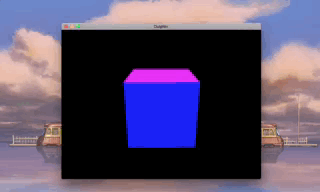
don't mind me i'm just rotating this cube in my mind with my computer
introduction
welcome to dolphin diary!
this will be a new, semi-regular series here on the blog where i document my progress as i make a videogame for the nintendo gamecube. the series name comes from the gamecube’s codename, dolphin, which is also the namesake of the emulator i’ll be using as my main target platform.
i've been thinking of embarking on this project for a little while now, but i wanted to wait until i had some confidence it was actually practical for me to attempt this in my spare time before i started blogging about it. after successfully writing the rotating cube program demonstrated in the GIF above, i've decided it's time to dive in![1]
these posts will be some mix of notes on game design, programming, tools, my general thoughts and feelings as i work on this game, and whatever other topics come up or interest me along the way.
what this will not be is a step-by-step guide or tutorial for programming the gamecube. this is all new to me and i'll be learning as i go, so i don’t have the expertise to write something like that. however, i will be linking to useful resources as i find them.
that said, if you’re reading this, i'm also curious to know what aspects of this project you are interested in - so please leave a comment if you have any topics you'd like me to write about!
how and why to make a gamecube game in the year 202X
let's start with the why!
lately i’ve been feeling the itch to make a 3D game for the first time in a long time, and i really enjoyed making a homebrew game for the GBA, so it made sense to me to adopt a similar approach for this new project
in my blog post about WITH THE LAST MOONBEAM i went into more detail about what i like about emulators as software platforms, but the short version is: i like the stability and portability of working in a virtual machine, and i find the constraints imposed by them to be creatively useful.[2]
so, why the gamecube specifically instead of some other machine? it has a robust homebrew toolchain, an actively maintained emulator that runs well enough on my aging macbook, and well, have you seen the thing? it’s too adorable not to write software for >:P
as for the how, i'll be figuring a lot of that out as i go, but here are the tools i know for sure i'll be using:
- toolchain / compiler: devkitPPC. devkitPro, the group that made the devkitARM toolchain i used to make MOONBEAM, also maintains a toolchain for the gamecube (and wii). i'm already familiar with how to use their tools, so that's a plus.
- emulator: dolphin. the emulator of choice for gamecube - it's been going strong for two decades now! i'll be using this to actually run the game on my computer.
next: 3d models
while i admit that i'm quite pleased with my cube, to make the kind of game i have in mind i'm going to want a little more variety of geometry, so i think the next thing i'm going to tackle is a way to load some simple static meshes
until next time, so long and thanks for all the fish!
[1]: get it?
[2]: and another thing: game making as a field - particularly the commercial mainstream - has problems with both sustainability and preservation. it's the norm for old games and systems to be tossed (sometimes literally) onto the scrap heap to make way for newer, and more profitable, iterations. in addition to the environmental harms, i think this prevents the development of a mature artistic tradition, one that is in conversation with past practitioners and forms (not merely nostalgically imitative). i hope to use making games for obsolete hardware as a very small way to counter this tendency, to encounter the material conditions of the art form's recent past and see what can be made of it in the present.
🐬 dolphin diary 🐬
this post is part of a series documenting my progress making a game for the gamecube. to see a full list of previous entries (and related resources), please click here! (p.s. you can also follow this blog via rss or email - thanks for reading!)
🌊🌊🌊